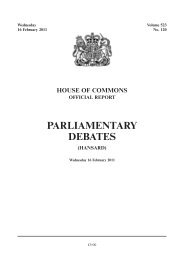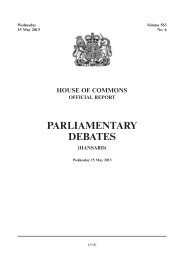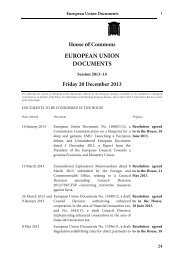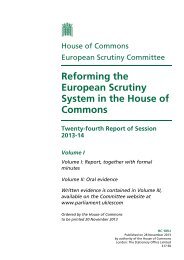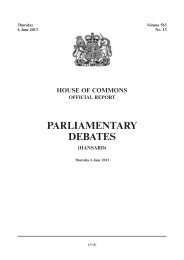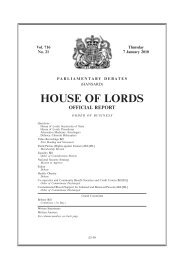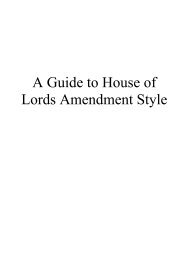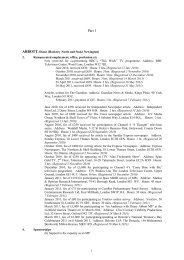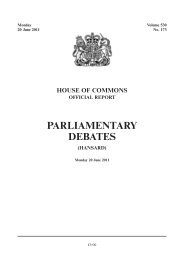Ticketing and Concessionary Travel on Public Transport - United ...
Ticketing and Concessionary Travel on Public Transport - United ...
Ticketing and Concessionary Travel on Public Transport - United ...
Create successful ePaper yourself
Turn your PDF publications into a flip-book with our unique Google optimized e-Paper software.
Ev 182 <strong>Transport</strong> Committee: Evidence<br />
4.3 Adequate publicity of the existence of penalty fares at specific stati<strong>on</strong>s <str<strong>on</strong>g>and</str<strong>on</strong>g> <strong>on</strong> specific routes is vital<br />
(<str<strong>on</strong>g>and</str<strong>on</strong>g> is a requirement of each penalty fare scheme) <str<strong>on</strong>g>and</str<strong>on</strong>g> robust safeguards must be in place to avoid innocent<br />
passengers who have inadvertently infringed the rules being issued with a penalty fare notice. Revenue<br />
protecti<strong>on</strong> inspectors have discreti<strong>on</strong> as to whether to issue a Penalty fare, in additi<strong>on</strong> to the appeals<br />
mechanism. The appeal mechanisms are, in our view, clear, though they are arguably not well publicised.<br />
All aspects of penalty fare schemes must be transparent; our principal areas of c<strong>on</strong>cern regarding Penalty<br />
fares remain: (a) ticket oYce queueing times preventing passengers from pre-purchasing a ticket without<br />
missing the train; (b) inc<strong>on</strong>sistency of approach—as menti<strong>on</strong>ed above; <str<strong>on</strong>g>and</str<strong>on</strong>g> (c) the perceived impartiality of<br />
the system. We have c<strong>on</strong>cerns over the perceived fairness of the appeals system where the industry (its<br />
appointed penalty fares inspectors <str<strong>on</strong>g>and</str<strong>on</strong>g>, of greater worry, the appeals processing staV) are judge <str<strong>on</strong>g>and</str<strong>on</strong>g> jury in<br />
the same case. Even as statutory passenger representatives we have no right to challenge upheld appeals—<br />
except to investigate whether they were c<strong>on</strong>ducted in accordance with the (unpublished) guidelines <str<strong>on</strong>g>and</str<strong>on</strong>g><br />
(publicised) penalty fares procedures.<br />
4.4 The provisi<strong>on</strong>s of the Bye-laws <str<strong>on</strong>g>and</str<strong>on</strong>g> Nati<strong>on</strong>al Rail C<strong>on</strong>diti<strong>on</strong>s of Carriage, which ultimately set out<br />
the rights <str<strong>on</strong>g>and</str<strong>on</strong>g> duties of both passengers <str<strong>on</strong>g>and</str<strong>on</strong>g> carriers, are almost wholly unknown to most passengers.<br />
Despite major improvements in the C<strong>on</strong>diti<strong>on</strong>s as a result of revisi<strong>on</strong>s in recent years, there is still much to<br />
do to enhance passenger benefits.<br />
4.5 It is clearly evident that too frequently rail operators do not protect farebox revenue suYciently<br />
robustly—for instance, through failure to police ticketless travel <strong>on</strong> board trains <str<strong>on</strong>g>and</str<strong>on</strong>g> at stati<strong>on</strong>s. Another<br />
failing is the frequent absence of facilities for those passengers who intend to pay but can find no means of<br />
doing so because either the stati<strong>on</strong> is unstaVed or because <strong>on</strong>-train staV fail to sell them a ticket. In either<br />
case, valuable income is lost which results in higher fares overall for those who do pay.<br />
4.6 Interim details of research 42 undertaken by Passenger Focus late in 2006 show an unacceptably high<br />
level of uncollected fares <strong>on</strong> <strong>on</strong>e set of rural/semi-urban routes from unstaVed stati<strong>on</strong>s. Passengers were<br />
unable to pay their fare in advance <str<strong>on</strong>g>and</str<strong>on</strong>g> also unable to pay aboard the train due to n<strong>on</strong>-appearance of <strong>on</strong>train<br />
staV. Either this means that the railway is losing revenue or the passenger is inc<strong>on</strong>venienced by having<br />
to queue at his destinati<strong>on</strong> to pay the fare. 43 In our survey researchers alighted at unstaVed stati<strong>on</strong>s so that<br />
revenue was lost.<br />
4.7 There is an urgent <str<strong>on</strong>g>and</str<strong>on</strong>g> growing need for wider implementati<strong>on</strong> of automatic ticket gates at stati<strong>on</strong>s<br />
with the highest footfall; it is equally vital to ensure that gates are staVed while ever trains are running.<br />
Installing gates results in a major increase in revenue to the extent that such facilities have paid for<br />
themselves within a year or so. Greater vigilance is also required to reduce the level of under-payment, such<br />
as adults travelling <strong>on</strong> Child fare tickets or with Railcard reducti<strong>on</strong>s to which they have no entitlement,<br />
al<strong>on</strong>gside n<strong>on</strong>-payment.<br />
4.8 Too often the gates are left unattended <str<strong>on</strong>g>and</str<strong>on</strong>g> open after mid-evening, with the result that late-night<br />
trains carry a number of n<strong>on</strong>-paying passengers, who probably feel that they can travel without being<br />
challenged to show a valid ticket. As gates permit holders of all valid tickets to pass through, there is a need<br />
for <strong>on</strong>-train ticket examinati<strong>on</strong> to prevent over-riding <str<strong>on</strong>g>and</str<strong>on</strong>g> also, ultimately, for gates at lesser-used stati<strong>on</strong>s<br />
to ensure that passengers pay the correct fare for their journey. A ticket to the next stati<strong>on</strong> will work the<br />
entry gates perfectly adequately; a fraudulent passenger getting oV at an ungated destinati<strong>on</strong> ten or more<br />
stati<strong>on</strong>s down the line need <strong>on</strong>ly pay the fare to the first stati<strong>on</strong> to access the system.<br />
4.9 It is virtually impossible for staV to check tickets accurately at n<strong>on</strong>-automated ticket barriers at busy<br />
times under normal circumstances.<br />
4.10 “Blitzing” ungated stati<strong>on</strong>s with ticket inspectors <str<strong>on</strong>g>and</str<strong>on</strong>g>, where necessary, the British <strong>Transport</strong> Police,<br />
is necessary to prevent as far as possible, fraudulent travel to <str<strong>on</strong>g>and</str<strong>on</strong>g> from such locati<strong>on</strong>s. Such acti<strong>on</strong> is also<br />
beneficial at major interchange points <str<strong>on</strong>g>and</str<strong>on</strong>g> at terminals, especially those without automatic gates.<br />
4.11 On-train inspecti<strong>on</strong> is also important <strong>on</strong> l<strong>on</strong>ger-distance routes to ensure that passengers have a<br />
valid ticket for the entire journey—not merely a short secti<strong>on</strong> at either end; in any case, regular <str<strong>on</strong>g>and</str<strong>on</strong>g> frequent<br />
appearance of <strong>on</strong>-train staV provides an enhanced level of customer service bey<strong>on</strong>d revenue protecti<strong>on</strong><br />
duties: enhanced sense of pers<strong>on</strong>al security; a deterrent against v<str<strong>on</strong>g>and</str<strong>on</strong>g>alism; <str<strong>on</strong>g>and</str<strong>on</strong>g> assistance for those<br />
passengers in need, which in themselves may persuade more passengers to make further rail journeys <str<strong>on</strong>g>and</str<strong>on</strong>g><br />
increase farebox revenue.<br />
42 The research, due for publicati<strong>on</strong> mid to late March 2007, covers purchase facilities for tickets at stati<strong>on</strong>s (booking oYces/<br />
ticket machines), telesales, websites <str<strong>on</strong>g>and</str<strong>on</strong>g> aboard trains. Details will be forwarded to the <strong>Transport</strong> Committee.<br />
43 Not <strong>on</strong>ly does this unduly <str<strong>on</strong>g>and</str<strong>on</strong>g> unnecessarily delay passengers, it can c<strong>on</strong>tribute to them missing c<strong>on</strong>necti<strong>on</strong>s. This is<br />
intolerable—more so where <strong>on</strong>ward services are infrequent.



